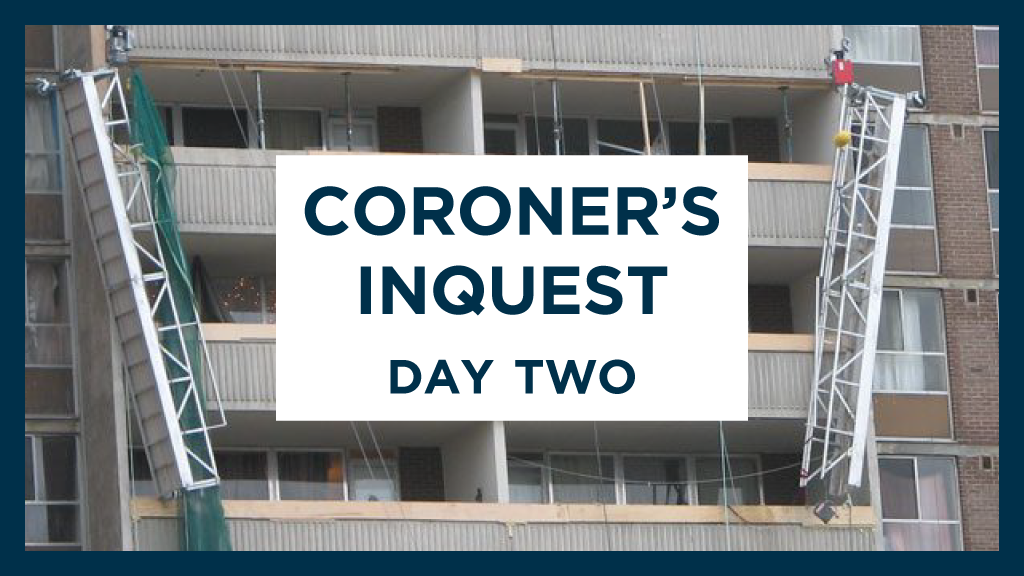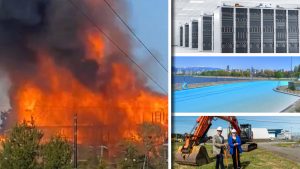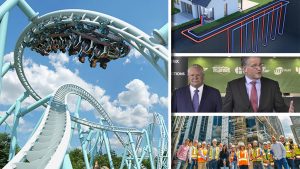Ontario’s construction health and safety landscape underwent significant reforms in the wake of the swing stage incident that took the lives of four workers in 2009, a coroner’s inquest heard Tuesday (Feb. 1).
But a lawyer representing the Building Trades at the inquest was persistent in asking whether there is still lots of room for improvement.
Day two of the inquest into the deaths of Metron Construction site supervisor Fayzullo Fazilov and workers Vladimir Korostin, Aleksey Blumberg and Alexander Bondorev on Christmas Eve 12 years ago heard from two Ministry of Labour, Training and Skills Development (MOL) witnesses who outlined how the ministry reacted to the tragedy.
The workers fell 13 storeys to their deaths when their swing stage platform broke apart at an apartment restoration jobsite in Toronto.
Dr. John Carlisle is serving as inquest officer.
Action in the aftermath
Long-time MOL policy executives William Roy and Filomena Savoia, the latter semi-retired after 34 years with the ministry, spent three-quarters of the day discussing the immediate aftermath of the deaths of the Metron workers and how a special advisory panel led by deputy minister Tony Dean consulted broadly to come up with a package of 46 recommendations for reform. Many were implemented, including the creation of the Chief Prevention Officer and numerous regulatory improvements to health and safety training and responsibility systems.
“We’re raising the bar up so that this doesn’t ever happen again,” said Roy.
Later in the day, however, Building Trades counsel Craig Flood of the firm Koskie Minsky sought to identify potential flaws in the reformed system.
Roy had noted that falls from heights had dropped 25 per cent since mandatory training was implemented in 2015.
“Is it accurate to say that falls from heights are generally still a hazard that inspectors deal with regularly?” Flood asked.
“I would say so, the top three,” said Roy, noting falls are behind only motor vehicle incidents as causes of fatalities in construction.
Later, Flood asked, “So even though there’s been a 25-per-cent reduction over the relevant time frame, there remains room for improvement in this area. Would you agree with that?”
“Absolutely, yes,” replied Roy.
Flood continued the approach and later established that supervisors of employees working from heights do not need specific heights training if they themselves will not be working from heights, though there are other duties by law.
Earlier, Roy recounted how the MOL acted swiftly in the immediate aftermath of the incident. It was determined that the 40-foot swing stage had been fabricated by Swing N Scaff of Ottawa.
“In the early days, we started to understand the reason or potential reason for that collapse,” said Roy. “So we actually went to the supplier Swing N Scaff and got an inventory of all the different locations across the province whereby he had rented or sold his equipment. We immediately sent inspectors out to stop work on all of those platforms.”
A blitz of inspections followed with inspectors first trained up to recognize deficiencies and then stopping and investigating every suspended access stage in the province.
In March of 2010 Dean was tapped to chair the advisory panel and the panel’s seminal report was published that December.
Evolving regulations
Questioned by inquest counsel Jai Dhar, Roy explained that among the wholesale legislative and regulatory changes introduced in 2017, the responsibilities of a “competent” supervisor under the Occupational Health and Safety Act became much more explicit.
Under the previous system, Roy said, an employer was required to do everything reasonable for the protection of a worker.
“This is all reasonable stuff,” he said of the reforms. “It just wasn’t explicitly in the legislation.
“What’s happened now is we’re putting it into the regulation.
“So it’s the government moving from implying, ‘the legislation’s all there.’ We did have legislation in place which should have covered it, but there were holes, there were gaps in the system that allowed this to happen. This is plugging those gaps.”
Roy further outlined how inspections, maintenance and record-keeping duties have been significantly expanded as well. Before the incident, there was no annual testing for structural components, no written records to track inspection, testing and maintenance, no references to CSA standards for inspection, no daily functions tests required nor annual inspection for fixed supports.
Now, there is prescribed operator and installer training; new requirements for roof plans and work plans; new requirements for permanent equipment logs to record inspections, tests, repairs and maintenance of suspension equipment; and notices of plans must be submitted to the MOL at least 48 hours before each system is used for the first time.
Follow the author on Twitter @DonWall_DCN.











Recent Comments
comments for this post are closed